The Look of Love: Visual Education in La chartreuse de Parme
Abstract
Even non-specialists cannot help but recognize the importance of the visual in Stendhal, whose narrator in Le rouge et le noir comments at every turn on his protagonist‘s eyes and glances. The same can be said of La chartreuse de Parme, whose tangled economical, social, and political subplots risk diverting the reader‘s attention from its primary focus: the search for love. Klaus Engelhardt notes that “[o]n ne saurait donc, en face de tant d‘évidence, trop insister sur l‘aspect visuel du livre qui, semble-t-il, n‘a pas assez retenu l‘attention des critiques. [”¦] [S]eule une vue d‘ensemble du complexe visuel peut donner toute la mesure de l‘aspect spectaculaire du roman. Il semble, en effet, que l‘unité esthétique du livre, souvent mise en question par la critique, est essentiellement liée à ce complexe.” What Engelhardt leaves unexplored is the visual dynamic between Fabrice and Clélia. My article bridges the gap between studies like his, which look at individual scenes privileging the visual, and Suzanne Pons-Ridler‘s, which simply counts occurrences of key vocabulary, by undertaking a close analysis of the network of visual references as they relate to the characters‘ emotional development over time, their éducation sentimentale.


